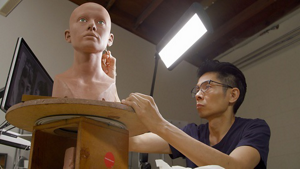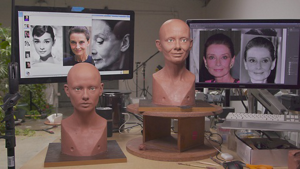Art × Science: Face Project
<Production Report No. 1> Audrey Hepburn Models for a Study of Facial Beauty in Sculpture
Kazu Hiro Delves into the Secrets of Graceful Beauty
This is an English translation of information in Japanese on November 20, 2020.
To explore the secret behind faces with radiant individuality from the dual standpoints of art and science, Kao Corporation has launched a joint research project with Kazu Hiro, a contemporary artist known for creating ultra-realistic busts of famous people at twice their real-life size. The project was announced in May 2019.
This series focuses on the process Kazu Hiro uses to bring his life-like creations into being. In This first report describes how he selects the models for his sculptures and the approach he takes to delve into the secrets of attractiveness.
Rebirth of a legend

Kazu Hiro chose Audrey Hepburn (1929-93), the celebrated Hollywood actress, fashion icon and UNICEF ambassador, as the model for his research. Hepburn starred in the Hollywood classics Roman Holiday and Breakfast at Tiffany's, among a dozen and a half films, in roles brought to life by her exceptional beauty and personality. Kazu Hiro easily singled her out as the ideal research subject in his search for a face radiant with unique beauty.
The acclaimed special effects makeup artist Kazu Hiro has spent many years on the front lines in modern-day Hollywood in close contact with the faces of actors. With the passing of time, he has come to observe that relatively few of the actors he works with succeed in maintaining their distinctive beauty as they age. When Audrey Hepburn advanced into her middle years as an A List celebrity, she maintained a perfect balance between her public and private personas, never allowing herself to be hounded by the cinema world. She maintained a trademark individuality set aglow by an inner self unburdened by pride, arrogance, or guile. The purity of her spirit was reflected in her facial appearance.
Kazu Hiro has revived the inner beauty of Audrey Hepburn in lifelike silicon sculpture of her face at double scale.
The production process
Before beginning production, Kazu Hiro gathered all of the information and materials he could find on Audrey Hepburn. He strove to understand her inner essence not just by studying her facial appearance in photographs, in the roles she played on screen, and in documentaries in which she appeared as herself, but by reading through her biographies and other books in which she appears. His portraits of depict her not as she appeared in her roles as an actress, but as the real-life Audrey Hepburn. The most important source materials for Kazu Hiro were the documentaries and interview footage in which he could observe the expressions of her face in unexpected moments.
Once he had viewed his many materials and fleshed out the concept to underpin his sculptures, Kazu Hiro set about sculpting figures in clay. He began by creating a clay image of Hepburn's face at actual size. His priority at this stage was to reproduce the shape of the face as accurately as possible. Accurately sculpting individual parts such as the eyes, nose, and mouth was only one step of the process. He also had to carefully recreate the distances between the parts of the face and their respective proportions. The slightest misalignment at this stage would be amplified in the double life-size sculptures to come, and would be doubly difficult to correct.
Kazu Hiro likened his work at this stage to the process of creating a map. He sculpted the face with guidance from numerical data he had gathered on the structures of his subject's facial components.
In the process he noticed that the individual parts of Hepburn's face coalesced into a supremely beautiful whole. The angle of her eyes, the contours of her nose, and the shape of her mouth were perfectly balanced, symmetrical, and proportioned similar to the face of a child. Kazu Hiro speculated that these proportions helped convey Hepburn's image of pure, unsullied beauty.
Once the facial outlines had been completed, Kazu Hiro's next step was to sculpt Hepburn's inner essence and expression as he wished them to be seen. In this process he visualized an image of the real-life Audrey Hepburn merged with the image expressed by the sculpture itself.

Simultaneous creation of two sculptures
Before starting on Audrey Hepburn, Kazu Hiro had sculpted nine portraits of celebrities and historical figures, including Abraham Lincoln and Andy Warhol. In working on Hepburn, he took on the new challenge of creating two separate sculptures, one of her as a young woman and the other portraying her toward the end of her life. He did so to achieve a core aim of this joint research project, namely, to portray a woman who ages gracefully.
The first of Kazu Hiro's portraits of Hepburn depicts her in her mid-twenties, when she had been working as a ballerina and was scouted to star in a film. Hepburn won an Academy Award and instant fame for her performance in her first Hollywood film, Roman Holiday. In Kazu Hiro's portrait of the young Hepburn, he aimed to depict her youthful innocence, her insecurity as a person lacking life experience, and her fledgling confidence as a person still forming an identity.

The second portrait reveals a Hepburn toward the end of her life. Hepburn had left Hollywood years earlier to raise her children, and later devoted herself to humanitarian work in her position as Goodwill Ambassador for UNICEF. All through her life, Hepburn had carried with her vivid experiences as a firsthand witness of human suffering in the Second World War. During her later years she was more concerned with those around her than with herself. In Kazu Hiro's second portrait, he strove to portray her all-embracing maternal nature, including aspects of her character that she revealed only to her family and acquaintances.
In Kazu Hiro's own words: "A person's way of life is carved in their facial expression. We grow older day by day and our faces are molded in the process".
* This is not a realistic rendering of the subject but the artist’s interpretation.


About Kao
Kao creates high-value-added products that enrich the lives of consumers around the world. Through its portfolio of over 20 leading brands such as Attack, Bioré, Goldwell, Jergens, John Frieda, Kanebo, Laurier, Merries and Molton Brown, Kao is part of the everyday lives of people in Asia, Oceania, North America and Europe. Combined with its chemical division, which contributes to a wide range of industries, Kao generates about 1,500 billion yen in annual sales. Kao employs about 33,000 people worldwide and has 130 years of history in innovation. Please visit the Kao Group website for updated information.
Media inquiries should be directed to:
Corporate Communications
Kao Corporation
